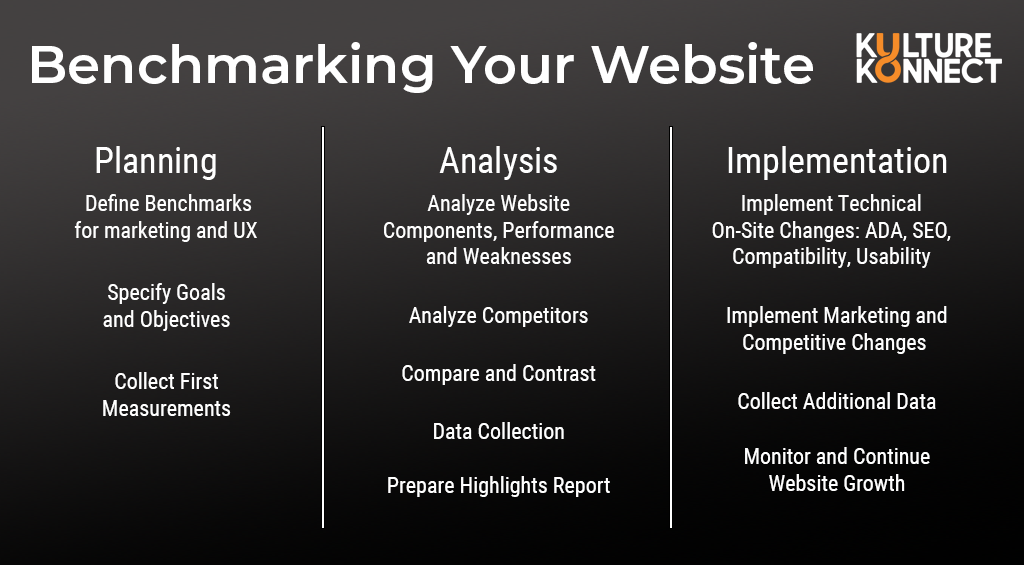
Cutting-Edge Marketing to Grow Your Business.

Let’s face it—completely redesigning your business’s website can feel like a huge risk. After all, your site is often the first look that customers and clients get of your company, so making a good first impression can have a pivotal impact on sales, networking, and business relationships, as well as public opinion. That’s why revamping a website that is highly relevant to the target audience, seamless to navigate and access online for all users, and effective in propelling potential customers along their buying journey can do much to elevate your company above the competition.
By benchmarking your site’s current metrics during website redesign, it’s simple to assess both how your site compares to others, as well as how your redesigned site compares to the original version. With clear key performance indicators (or KPI) unique to your company’s definition of success, it’s much easier to see your business’s strengths and weaknesses, as well as develop strategies to improve online performance and authority.
But what exactly are the metrics your company should focus on in a website design? The reality is, every business model and every company can–and should–use different metrics to measure success. An e-commerce site should have vastly different goals, and use vastly different types of metrics to benchmark, than a brochure page.
Keep reading to discover more about metrics, why benchmarking with metrics is truly so important, and ways to measure your own metrics!
But there’s more to launching a successful site than just understanding why you need benchmark metrics—it’s also crucial to know how to be successful with your website using analytics.
When it comes to websites and online platforms, there are quite a few tools out there to help you analyze data and fine-tune your business’s web experience, some of them are: Google Search Console, Ahrefs, SEMrush, mozpro, and countless others, although Google Analytics is generally the most recommended option. There are also professional companies that can help simplify the process too.
Either way, when analyzing your website’s metrics, it’s important to follow a process where you plan, analyze and then implement changes. Here is a quick list of steps to follow:

Additionally, the importance of lead generation and conversation should also be a major factor in how you measure the success of your website. This valuable data lets you know not just how many people are visiting your page, but more importantly, if the visitors are doing what you want them to do. Whether that’s making a purchase, requesting more info, or driving up engagement.
As a business owner or marketer, you’ve probably found yourself searching for things such as “what is my SEO ranking” or “how to measure my SEO ranking.” There are metrics that will tell you precisely where you’re landing on search engine pages. Some of the best ways to determine your company’s SEO ranking include organic traffic, click-through-rate (CTR), and keyword ranking, but there are plenty of other metrics that can show your standing as well. After examining the analytics, making a couple of tweaks can get your page bumped higher and seen by more of the right potential customers.
Building a successful website using data and benchmark metrics is highly lucrative for businesses and offers a huge return on investment (ROI). In addition to an increased ability to oversee exactly which elements of your website are successful, it also ensures that any changes made to your website are the right changes. Having a data-approved website can also improve brand reputation and public image. All of this results in a lot of savings and a lot of extra generated income for your business.
Website benchmarking should be an ongoing practice in any business. Knowing what metrics your company should be using to benchmark your redesigned website’s success works as a reality check and it is only the first step of the process. Once you determine what data you should be keeping a close eye on, the next step is figuring out how to get the results you want in that data to drive more effective marketing campaigns and identify areas that need optimization. And there’s more on that—plus plenty of other insider information about how to boost your website’s effectiveness—coming next week!



Lorem Ipsum is a simple dummy text used as a dummy text contents. Lorem ipsum will be replaced. Lorem Ipsum is a simple dummy text used as a dummy text contents. Lorem ipsum will be replaced.Lorem Ipsum is a simple dummy text used as a dummy text contents. Lorem ipsum will be replaced.




